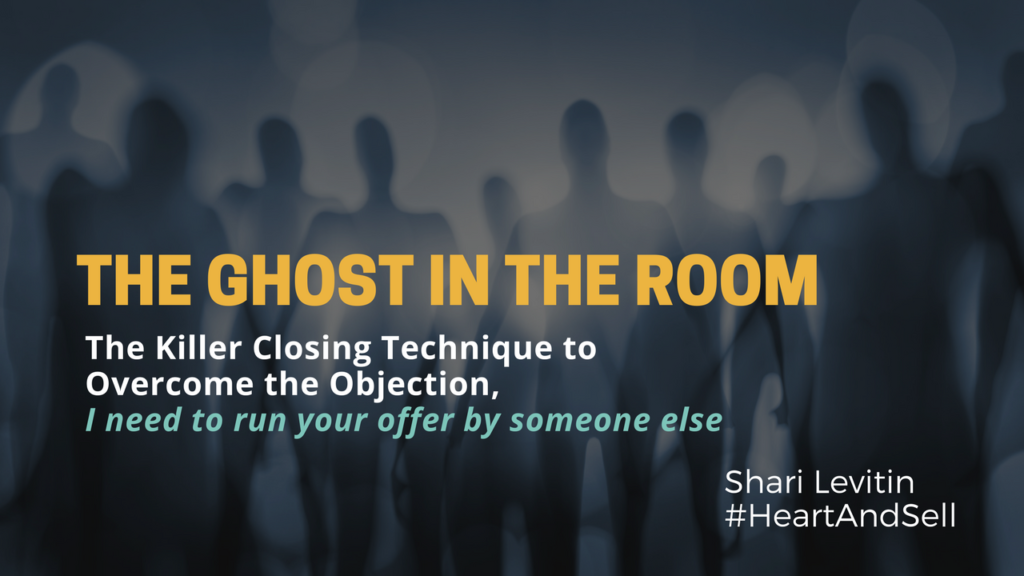It happens all the time. You’re lucky enough to land a qualified prospect, you create strong rapport, your customer loves your product, the price is right.
add_action('wp_footer', function() {
?>
<script>
document.addEventListener("DOMContentLoaded", function() {
// Find the social icons container
var socialIcons = document.querySelector(".nectar-social");
if(socialIcons) {
// Create the button element
var btn = document.createElement("a");
btn.href = "/become-an-insider/";
btn.className = "header-insider-btn";
btn.innerText = "Become an Insider";
// Insert it AFTER the social icons
socialIcons.parentNode.appendChild(btn);
}
});
</script>
<?php
});
There’s just one problem. They need to speak with their brother (or mother, or doctor, or lawyer, or board members) about it. This brother, of course, is vacationing in Italy and can’t be reached.
I call this third party “The Ghost in the Room.”
When your customer asserts they need to speak with someone else, determine if this is an excuse or, in fact, a true objection before attempting to overcome it.
Too many salespeople challenge the customer’s excuse by blurting out “Let’s get the ‘ghost’ on the phone,” or “I’m sure he’ll love it—let’s draw up the paperwork.” The problem? Even if you succeed in getting the third party on the phone, you must still address the customer’s true, and final, objection to making a purchasing decision.
[Tweet “Remember, people would rather make no decision than make the wrong decision. #HeartAndSell”]
The more complicated your product presentation, the longer your customers will put off their decision making process. Also, the harder you push, the more your customers will resist.
Next time your customer says “I need to run this by my brother, mother, dentist, or board members,” consider the following technique. The first time I saw it, I was enthralled.
Ira Volker was selling a membership in a very upscale senior living community to an older couple in Scottsdale. The prospects, Mr. and Mrs. Bayfield, liked the idea of resort-style living; the activities, education, and entertainment went beyond anything they could have imagined.
After completing the tour, Ira asked for the order. The Bayfield’s assured him they were interested but just needed to confer with their grown children.
The conversation went like this:
Mrs. Bayfield: We’ll have to get back to you after we talk to our kids.
Ira: No problem—I completely understand. Just out of curiosity, if your kids don’t approve this, I assume you will say no to this community?
Mr. Bayfield: Probably. We would really like to get their opinion, as they’ll be the ones visiting us here.
Ira: That makes sense. Now if they say yes, will you go ahead with this?
Mrs. Bayfield: Absolutely.
Ira: Why would you want to move here? (Pause. This is the hard part, especially for salespeople. Be quiet and let them give you an answer!)
Mr. Bayfield: Well, we love the community aspect. We have friends here, and we’d rather move to a place like this now, before one of us is ill.
Do you see what happened? The Bayfield’s confirmed their own reasons for purchasing. Ira let them realize on their own that talking to their children was unnecessary. This technique incorporates a scientific principle called cognitive dissonance.
Cognitive Dissonance is defined as the disconnect that sets in if we feel that our actions don’t align with our beliefs.
The Bayfields’ true concern was to establish a secure environment for their old age. They saw that the act of speaking to their children first had nothing to do with their real goal.
Once they recognized their cognitive dissonance, they were able to make their own decision. When you ask the customer why they would say yes, you’re encouraging them to articulate all of the reasons in favor of your product or service.
[Tweet “No one believes it when we say it. They believe it when they say it. #HeartAndSell #Sales”]
So next time your customer claims he needs to speak to someone else who is somewhere else, make the invisible visible by calling out the ghost in the room.
